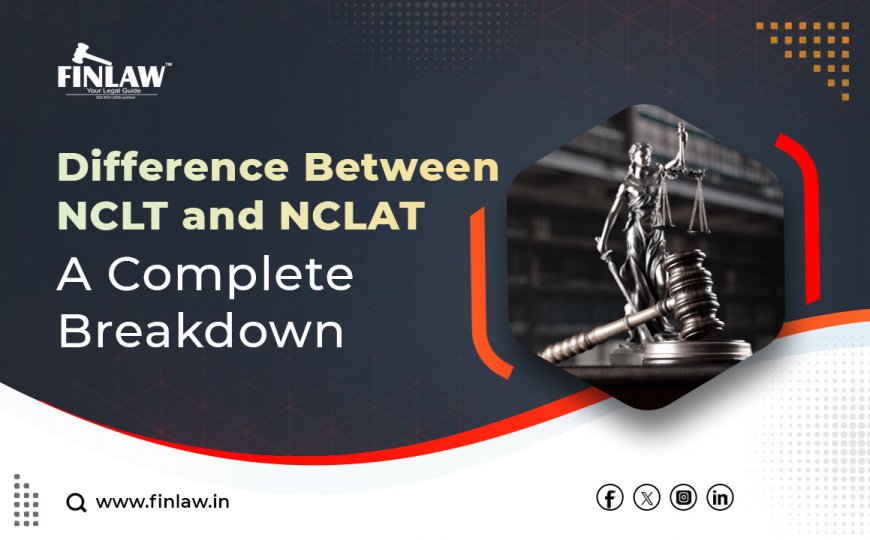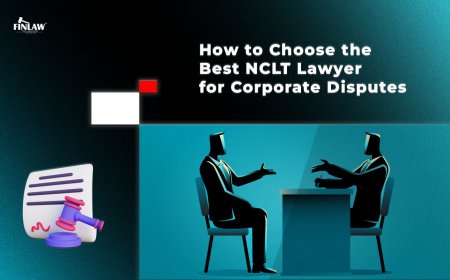Difference Between NCLT and NCLAT: A Complete Breakdown
Understand the difference between NCLT and NCLAT, their roles, functions, and importance in India's corporate legal framework—a complete breakdown.

The corporate legal landscape in India underwent a significant transformation with the establishment of the National Company Law Tribunal (NCLT) and the National Company Law Appellate Tribunal (NCLAT). These institutions were introduced to streamline the adjudication process for corporate disputes, insolvency proceedings, and other company-related matters. While they function within the same legal framework, understanding the distinctions between NCLT and NCLAT is crucial for professionals, businesses, and legal practitioners seeking effective legal remedies.
What is NCLT?
National Company Law Tribunal (NCLT): Established under Section 408 of the Companies Act, 2013, the NCLT serves as a quasi-judicial body to adjudicate disputes pertaining to company law and corporate affairs. It commenced operations on June 1, 2016, replacing the Company Law Board (CLB) and inheriting its functions.
Key Functions of NCLT
-
Insolvency Resolution: Acts as the adjudicating authority for insolvency resolution processes of companies and limited liability partnerships (LLPs) under the Insolvency and Bankruptcy Code (IBC), 2016.
-
Company Law Matters: Handles cases related to oppression and mismanagement, winding up of companies, and other disputes arising under the Companies Act.
-
Mergers and Amalgamations: Approves schemes of mergers, demergers, and corporate restructuring.
-
Restoration of Companies: Deals with the restoration of struck-off companies and the rectification of company registers.
-
Investor Protection: Safeguards the rights of stakeholders by addressing grievances against company management.
What is NCLAT?
National Company Law Appellate Tribunal (NCLAT): Constituted under Section 410 of the Companies Act, 2013, NCLAT functions as an appellate authority to hear appeals against the decisions made by the NCLT. It also began its operations on June 1, 2016, and serves as a higher authority for reviewing NCLT orders.
Key Functions of NCLAT
-
Appellate Jurisdiction: Hears appeals against orders passed by the NCLT.
-
Competition Law Appeals: Since May 26, 2017, NCLAT also serves as the appellate tribunal for orders passed by the Competition Commission of India (CCI).
-
Insolvency Appeals: Addresses appeals against NCLT orders under the IBC.
-
Appellate Authority for IBBI: Hears appeals against orders issued by the Insolvency and Bankruptcy Board of India (IBBI).
-
Judicial Review: Ensures the correctness of NCLT decisions by evaluating the legal and factual basis.
Key Differences Between NCLT and NCLAT
|
Criteria |
NCLT |
NCLAT |
|
Establishment |
Established under Section 408 of the Companies Act, 2013 |
Constituted under Section 410 of the Companies Act, 2013 |
|
Jurisdiction |
Original jurisdiction for corporate disputes and insolvency cases |
Appellate jurisdiction over NCLT and CCI orders |
|
Scope of Work |
Fact-finding, evidence collection, adjudication |
Reviews and evaluates legal correctness of NCLT orders |
|
Appeals |
Decisions appealable to NCLAT |
Decisions appealable to the Supreme Court of India |
|
Nature of Proceedings |
Quasi-judicial, first point of adjudication |
Appellate, reviewing previous judgments |
Appeal Process Explained
-
From NCLT to NCLAT: Parties aggrieved by an NCLT order can appeal to the NCLAT within 45 days of the order's issuance.
-
From NCLAT to Supreme Court: Decisions of the NCLAT can be further appealed to the Supreme Court of India on points of law within 60 days.
-
Grounds for Appeal: Appeals can be made on grounds such as misinterpretation of law, legal errors, or procedural irregularities.
Importance of NCLT and NCLAT in Corporate Governance
-
Efficiency in Dispute Resolution: The NCLT and NCLAT have simplified the process of corporate dispute resolution, reducing the burden on civil courts.
-
Speed and Effectiveness: With specialized benches and expertise, these tribunals ensure timely resolution of complex corporate disputes.
-
Investor Confidence: Transparent and structured dispute resolution mechanisms boost investor confidence, aiding in business growth.
-
Regulatory Oversight: NCLT and NCLAT ensure compliance with corporate laws, preventing fraudulent activities and mismanagement.
Challenges and Criticisms
NCLT:
-
Case Backlog: Despite intentions for swift resolutions, NCLT faces a growing backlog of cases, leading to delays.
-
Resource Constraints: Limited benches and infrastructure have been cited as factors hindering its efficiency.
-
Jurisdictional Complexity: Overlap of jurisdiction with other courts can lead to conflicting decisions.
NCLAT:
-
Overwhelming Appeals: An increasing number of appeals have put pressure on NCLAT, affecting its ability to deliver timely judgments.
-
Scope of Jurisdiction: With the addition of competition law appeals, concerns about overextension and capacity have arisen.
-
Limited Finality: Since appeals from NCLAT go to the Supreme Court, its decisions are not always final.
Recent Developments and Landmark Cases
-
Jet Airways Insolvency Case: Demonstrated the coordination between NCLT and NCLAT in handling large-scale insolvency proceedings.
-
Essar Steel Case: Marked a significant judgment by NCLAT, later reviewed by the Supreme Court, showcasing its role in major insolvency resolutions.
Conclusion
The NCLT and NCLAT play a pivotal role in India's corporate legal framework. Understanding the difference between NCLT and NCLAT can help businesses, legal professionals, and stakeholders navigate the complexities of corporate laws effectively. As these institutions continue to evolve, their efficiency and role in shaping India's corporate landscape will remain critical. With rising corporate disputes and insolvency cases, the relevance of NCLT and NCLAT is set to grow further.
What's Your Reaction?



















